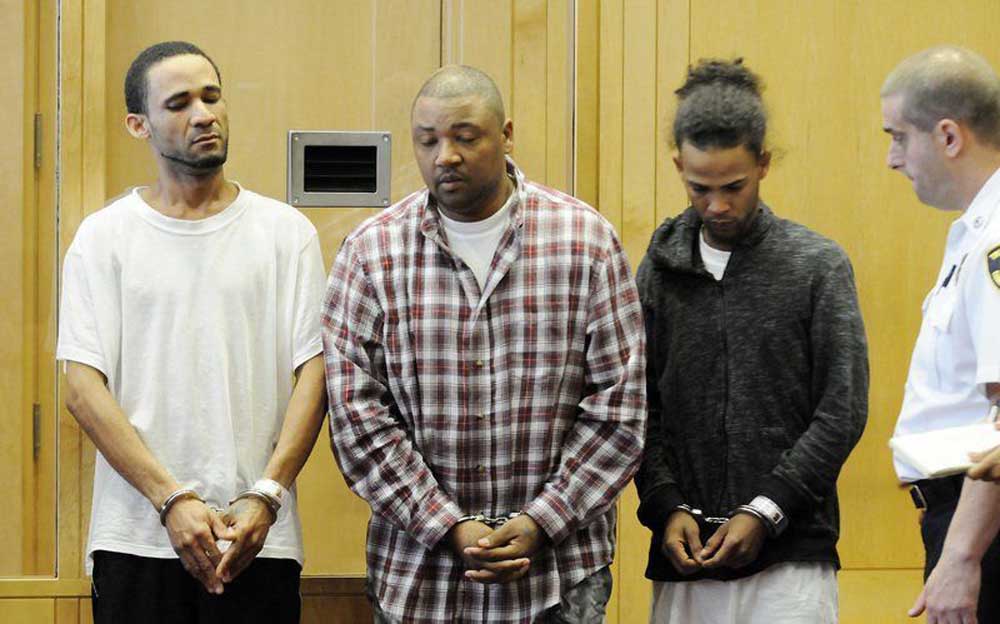‘Immigrant City’ would make itself a sanctuary
Published 2:00 pm Friday, July 24, 2015

- Jose Lara, 35, left, Wilton Lara-Calmona, 38, and Christopher Paganmoux, 23, at their arraignment on drug charges in Lawrence District Court.
LAWRENCE, Mass. — A northeastern Massachusetts city that bears the nickname “Immigrant City” – nearly 40 percent of its residents were born overseas – may join San Francisco and other major municipalities to be designated a “sanctuary city,” a place that provides haven against deportation for those who have immigrated illegally.
The proposal to limit the city of Lawrence’s cooperation with U.S. Immigration and Customs Enforcement agents come even as police hold a suspect in a July 4 shooting death who was ordered deported last year and another who was facing a deportation hearing.
Trending
The immigration status of the two men was only made public over the weekend, so their arrests have not yet become part of the nationwide debate over immigration and sanctuary cities. That debate was fueled most recently by the shooting death of 32-year-old Kathryn Steinle while she walked along a San Francisco pier with her father on July 1. Steinle was allegedly shot by Juan Francisco Lopez-Sanchez, a Mexican citizen with a long criminal record who had been deported five times.
The hot-button issue has also been exacerbated by comments from Republican presidential candidate Donald Trump, who has made crimes committed by people who are here illegally a centerpiece of his campaign.
A House vote is expected Thursday on a bill by Republican Congressman Duncan Hunter of California that would block federal funding to these so-called “sanctuary cities,” or cities that don’t honor federal immigration requests.
While the term “sanctuary city” has no true legal meaning, it refers generally to cities with sanctuary policies, which emerged in the 1980s as a response to a massive wave of immigrants to the U.S. who were fleeing civil wars and feared deportation back to their war-torn homelands. In addition to San Francisco, numerous cities around the U.S. – including Los Angeles, New York City, Chicago, Seattle, Dallas, and Portland, Oregon – are considered sanctuary cities.
Immigration rights advocates say that sanctuary policies help to build trust with the millions of people who are in the country illegally but live lawful lives while here, which in turn helps public safety.
Trending
Demographics suggest there will be at least some support for the measure in Lawrence: 37.6 percent of the city’s 78,000 residents were born overseas, according to the U.S. Census. News of the proposed policy comes as two men are being held on drug-related charges while police investigate whether they are connected to the shooting death of Mirta Rivera, a 41-year-old woman who was shot in the head by a bullet fired through the floor of the apartment above hers, where they lived.
Jose Lara-Mejia, a 35-year-old Dominican, was being sought by ICE agents after he skipped a hearing on his request for asylum following his arrest along the Mexican border two years ago, according to Shawn Neudauer, a spokesman for the agency. He was ordered deported in April 2014.
A second suspect in the same shooting, Wilton Lara-Calmona, a 38-year-old Dominican, was deported in 2012, Neudauer said. He was arrested again on the Mexican border in November and was awaiting a hearing on his request for asylum, so he was in the United States legally at the time of the murder earlier this month.
In Lawrence, ICE has placed immigration detainers on Lara-Calmona and Lara-Mejia pending the outcome of their criminal cases here, meaning the agency has asked that they not be released. Even without ICE’s request, releasing the two would be unlikely given the drug charges against them and their possible connection to Rivera’s death.
City Council President Modesto Maldonado was not immediately available Monday to discuss whether the new information that two suspects in Rivera’s death were undocumented immigrants sought by ICE might affect his proposal to limit the city’s cooperation with the agency’s deportation efforts.
But in an earlier interview, Maldonado said the bill was intended to improve cooperation between city police and its immigrant community because it would remove the fear among immigrants that making their status known to police would result in a phone call to ICE.
“If they have a problem, they would not be afraid to call police because they won’t be detained and taken to Immigration,” Maldonado said.
He also emphasized that his bill would allow for the release of undocumented immigrants who commit only “minor infractions,” such as a traffic violation or a domestic dispute. He said the city does not have the resources to hold and process people whose most serious legal issue is that they’re undocumented.
As do police nationwide, Lawrence police automatically send data about local arrests to the FBI data base, allowing them to determine if suspects are wanted elsewhere. The FBI forwards the data to ICE, which often asks police to continue detaining suspects who are here illegally after the local allegations are settled.
Maldonado’s proposed bill would block police from responding to those requests from ICE, unless the agency has a criminal warrant signed by a judge for a suspect the city is holding. The bill also would block police from providing information about individuals the city is holding, unless ICE produces a criminal warrant.
The City Council on Aug. 11 is scheduled to set a date for a public hearing on the bill to make Lawrence a sanctuary city.
Keith Eddings of The Eagle-Tribune reported this story. Material from the Associated Press was used in this report.


